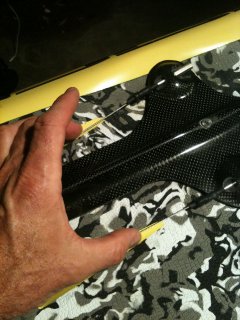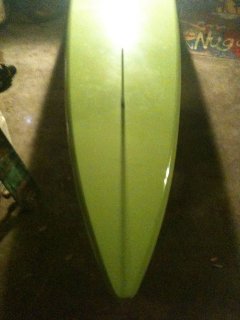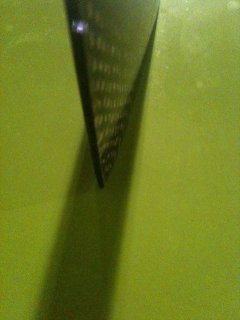Fine Tuning the Rudder by Robert Stehlik
I like racing on unlimited boards with rudders. The rudder makes these long, straight tracking boards surprisingly nimble and fun in the bumps. I avoid using the rudder when trying to catch a bump as it creates extra drag. Once planing on the bump though, using the rudder can help to follow the bumps or change direction without noticeably slowing the glide. You can step back with one foot to lift the nose of the board while keeping the front foot on the rudder. On steeper bumps you want to step further back with both feet off the rudder to reduce the wetted surface and allow higher speeds. With both feet off the rudder, you can surf the bump off the tail by using the rails like when surfing. When the front foot is off the rudder, it goes to “neutral”, the straight position that the rudder is supposed to return to when the pedal is released. To minimize drag from steering, the rudder should be in “neutral” most of the time with most steering being small adjustments from the straight position. Doing a downwinder on an unlimited board with the rudder not straight in neutral is awful, it’s like trying to play nice music on a guitar that’s out of tune. I’m surprised how many people suffer through downwind runs on boards that cost thousands of dollars with their rudder systems completely out of tune, or worse, dropping out of a race because their screws got loose ![]() (I won’t mention any names here).
(I won’t mention any names here).
If you live on Oahu and would like to have your rudder system tuned professionally, bring it to Blue Planet Surf Shop, for everyone else here is a do it yourself guide to fine tuning your rudder system. The pictures are of a SIC Bullet that my friend Evan Leong (standuppaddlesurf.net) is kindly letting me use in a race tomorrow. The basic concept can be used on any board, all rudder systems allow for a way to adjust and fix the neutral position.
Guide to tuning the rudder system
The SIC ASS system (Advanced Steering System) is notorious for the adjustment screws getting loose and out of tune. I don’t like to tune the rudder on a regular basis, so I put some loctite (red) on the screws before making the adjustments for a semi-permanent fixed setting that should not get loose or need any more adjustments for at least a season or longer. While you are at it, also put loctite on the screw in the center that holds down the pedal, I have heard of those coming loose as well.
Cable tension
The cables should be snug but not overtightened.
This picture shows about the correct amount of tension, you should be able to pull the cables together an inch or so, if you can pull more, the cable tension is too loose, which makes the steering sloppy. Tighter cables will make the system more responsive but if they are too tight the tension can put too much strain on the system. You want to avoid having loose parts or play in the system.
Lining up the Rudder
A friend asked me how I can tell if the rudder is really straight. It takes a good eye to line up the curved sides of the rudder with the curved bottom of the board. You can line up the tail or nose of the board with the rudder and see if it slants to one side or the other. If you don’t have that eagle eye, it helps to have a center line reference to line up the back tip of the rudder with.
Because this board does not have a visible centerline, I used a floodlight and lined up the board so the shadow of the fin made a centerline on the board.
I then centered the back tip of the rudder in the shadow, playing around with the tension until I have a good amount of tension with the rudder perfectly straight in neutral. Wiggle the rudder back and forth and make sure it keeps returning to neutral. If it gets stuck in different settings you should check if all parts move smoothly without getting stuck and/or create more tension pulling the rudder into the neutral position. The SIC system uses a fiberglass batten, other systems use rubber bands that may need to be tightened or replaced to pull the rudder into the neutral position.
Let the Loctite cure overnight, then get on the water and most importantly, have FUN.
For more tips from Robert, visit his Zen Waterman blog at http://zenwaterman.blogspot.com/.






0 Responses to “Fine Tuning the Rudder by Robert Stehlik”